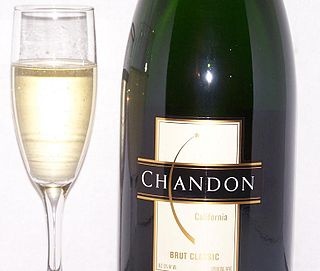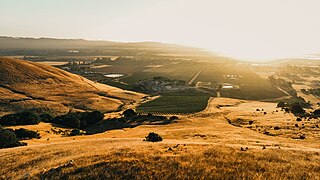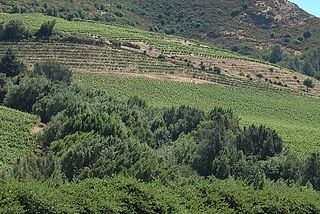
Chardonnay is a green-skinned grape variety used in the production of white wine. The variety originated in the Burgundy wine region of eastern France, but is now grown wherever wine is produced, from England to New Zealand. For new and developing wine regions, growing Chardonnay is seen as a 'rite of passage' and an easy entry into the international wine market.

Pinot noir or Pinot nero is a red-wine grape variety of the species Vitis vinifera. The name may also refer to wines created predominantly from pinot noir grapes. The name is derived from the French words for pine and black. The word pine alludes to the grape variety having tightly clustered, pinecone–shaped bunches of fruit.

Pinot Meunier, also known as Meunier or Schwarzriesling, is a variety of red wine grape most noted for being one of the three main varieties used in the production of Champagne. Until recently, producers in Champagne generally did not acknowledge Pinot Meunier, preferring to emphasise the use of the other noble varieties, but now Pinot Meunier is gaining recognition for the body and richness it contributes to Champagne. Pinot Meunier is approximately one-third of all the grapes planted in Champagne. It is a chimeric mutation of Pinot: its inner cell layers are composed of a Pinot genotype which is close to Pinot noir or Pinot gris; the outer, epidermal, layer is, however, made up of a mutant, distinctive, genotype. Pinot Meunier was first mentioned in the 16th century, and gets its name and synonyms from flour-like dusty white down on the underside of its leaves.

The Alexander Valley is a Californian American Viticultural Area (AVA) just north of Healdsburg in Sonoma County. It is home to many wineries and vineyards, as well as the city of Cloverdale. It is the largest and most fully planted wine region in Sonoma. Highway 101 runs through the valley, and the Russian River flows down the valley, surrounded by vineyards on both sides. From the higher elevations of the valley rim, there is a view as far south as Taylor Mountain and Sonoma Mountain. The region was named for Cyrus Alexander, owner of a part of the Rancho Sotoyome Mexican land grant, in 1847. Granted AVA status in 1984, the boundaries of the appellation are defined in the Code of Federal Regulations, Title 27, Section 9.53.

Chalone Vineyard is located in the Chalone AVA south of San Francisco, California, United States, on an unusual geological formation called the Gavilan benchland. The soil is rich in limestone and calcium carbonate and also contains a significant amount of decomposed granite. This soil has a mineral composition similar to the Champagne region of France. Chalone is situated in an arid chaparral environment, in which temperatures can vary as much as 50°F in one day. The climate is very dry, only 12 to 14 inches (360 mm) of rain fall per year. These factors combine to create a unique terroir, the signature profile of a wine growing region.

Bien Nacido Vineyards is cool-climate vineyard on the central coast of California. Located midway up the Santa Maria Valley, it is known for growing Burgundian and Rhone varieties of wine grapes. Bien Nacido has the distinction of being one of the major viticultural nurseries in the state for certified, varietal budwood. Most of the vines were originally from stock grown by the University of California at Davis. While the average increase block in California is less than 10 acres (40,000 m2), Bien Nacido Vineyards has several hundred acres of certified Chardonnay, Pinot Noir, Merlot and a number of other varieties. Much of the Chardonnay planted in California in the last twenty years began as Bien Nacido Vineyards cuttings.

Domaine Chandon is a winery located in the town of Yountville, California, in the Napa Valley. Established in 1973 by Moët et Chandon, and led by businessman John Wright, who operated the company for over 20 years, it was the first French-owned sparkling wine producer in the Napa Valley.

Ceja Vineyards is a family-owned winery in Napa founded by Mexican-American immigrants. The Ceja family have been growers in the Napa and Sonoma valleys in California for three generations. The wine production company was founded in 1999 and focuses on premium wines. The principals are; Amelia Moran Ceja, President; Martha Ceja, Vice President; Pedro Ceja, Secretary; and Armando Ceja, Treasurer. As of 2008 production is around 10,000 cases per year.

The Mendocino County wine is an appellation that designates wine made from grapes grown mostly in Mendocino County, California. The region is part of the larger North Coast AVA and one of California's largest and most climatically diverse wine growing regions. Mendocino County is one of the northernmost commercial wine grape regions in the state with two distinct climate zones separated by the Mendocino Range. Ten American Viticultural Areas have been designated within Mendocino County. Mendocino is one of the leading wine growing regions for organically produced wine grapes. Nearly 25% of the acreage in Mendocino County is grown organically. In 2004, the residents of the county voted to become the first GMO-free county in the United States in an initiative that was supported by many of the county's largest wineries. The county's widespread focus on organic viticulture has inspired journalists to describe it as "California's organic wine Mecca".

Sonoma County wine is wine made in Sonoma County, California, in the United States.

The Russian River Valley AVA is an American Viticultural Area (AVA) in Sonoma County, California. Centered on the Russian River, the Russian River Valley AVA accounts for about one-sixth of the total planted vineyard acreage in Sonoma County. The appellation was granted AVA status in 1983 and enlarged in 2005. The area generally lies between Sebastopol and Santa Rosa in the south, and Forestville and Healdsburg in the north. The Russian River Valley has a characteristically cool climate, heavily affected by fog generated by the valley's proximity to the Pacific Ocean. The area is known for its success with cool climate varietals, notably Pinot noir and Chardonnay.
The Oak Knoll District of Napa Valley AVA is an American Viticultural Area located within Napa Valley AVA at the southern end of the valley floor. The appellation's close proximity to San Pablo Bay results in a climate that is cooler and more moderate than any region in Napa Valley other than the Los Carneros AVA. The AVA has more vines planted to it than any other wholly contained appellation within the Napa Valley. A wide variety of wine grapes do well in this climate, including varieties not widely grown in other parts of Napa Valley, such as Riesling and Pinot noir. The district is planted largely to Merlot, Chardonnay and Cabernet Sauvignon, in that order. Oak Knoll District Chardonnay has a reputation for a restrained, delicate style. The appellation was officially designated an appellation within the Napa Valley AVA on April 26, 2004.

The Spring Mountain District AVA is an American Viticultural Area located in the Napa Valley AVA in California. Spring Mountain District AVA was officially established as an American Viticulture Area in 1993. Encompassed within its bounds are about 8,600 acres (3,480 ha), of which about 1,000 acres (400 ha) are planted to vineyards. Given the small crop yields on hillsides, the region represents less than 2% of Napa Valley wine. Currently the region has just over 30 winegrowers.

The Loire Valley wine region includes the French wine regions situated along the river Loire from the Muscadet region near the city of Nantes on the Atlantic coast to the region of Sancerre and Pouilly-Fumé just southeast of the city of Orléans in north central France. In between are the regions of Anjou wine, Saumur, Bourgueil, Chinon, and Vouvray. The Loire Valley itself follows the river through the Loire department to the river's origins in the Cévennes but the majority of the wine production takes place in the regions noted above. The area includes 87 appellations under the Appellation d'origine contrôlée (AOC) and Indication Géographique Protégée (IGP) systems. While the majority of production is white wine from the Chenin blanc, Sauvignon blanc and Melon de Bourgogne grapes, there are red wines made from Cabernet franc. In addition to still wines, rosé, sparkling and dessert wines are also produced. With Crémant production throughout the Loire, it is the second largest sparkling wine producer in France after Champagne. Among these different wine styles, Loire wines tend to exhibit characteristic fruitiness with fresh, crisp flavors-especially in their youth. The Loire Valley has a long history of winemaking dating back to the 1st century. In the High Middle Ages, the wines of the Loire Valley were the most esteemed wines in England and France, even more prized than those from Bordeaux.

California wine production has a rich viticulture history since 1680 when Spanish Jesuit missionaries planted Vitis vinifera vines native to the Mediterranean region in their established missions to produce wine for religious services. In the 1770s, Spanish missionaries continued the practice under the direction of the Father Junípero Serra who planted California's first vineyard at Mission San Juan Capistrano.

Benovia Winery is a family-owned producer of Pinot noir, Chardonnay, and Zinfandel wines in Santa Rosa, California. Founded in 2005 by Joe Anderson and Mary Dewane, Benovia Winery farms three estate vineyards which total 71.67 acres (290,000 m2) and are located in the Russian River Valley AVA and Sonoma Coast AVA in Sonoma County. To supplement the fruit it harvests each year, Benovia purchases additional grapes from two sites farmed by the Martinelli family. Benovia's winemaker, Mike Sullivan, is also co-owner of the winery. Benovia wines are produced and bottled at the winery's winemaking facilities at the Martaella Estate Vineyard in the Russian River Valley AVA. Annual production is approximately 6,000 cases. Benovia wines are sold direct to customers, as well as distributed to restaurants and other retailers for resale.

Gloria Ferrer Caves & Vineyards is a winery in Sonoma County, California that specializes in sparkling wines, as well as Pinot noir and Chardonnay wine. It was the first sparkling wine producer in Carneros. It was also the first to plant Champagne grape clones in the region.

Baldacci Family Vineyards is a family-owned winery located in the Stags Leap District AVA of Napa Valley. Established in 1998, Baldacci Family Vineyards owns over 50 acres of sustainably-farmed vines in three distinct Napa Valley appellations: Stags Leap District, Calistoga, and Los Carneros. The wine portfolio is focused on limited-production, estate-grown wines.

Artesa Vineyards & Winery is a winery located in Napa, California in the United States.

Moon Mountain District Sonoma County is an American Viticultural Area (AVA) within Sonoma Valley and North Coast viticultural areas, just north of the city of Sonoma. This mountainous region on the very eastern edge of Sonoma County has a historic reputation for producing rich, intensely-flavored wines from Cabernet Sauvignon and Syrah varietals since the 1880s. The District was established on November 1, 2013, by the Alcohol and Tobacco Tax and Trade Bureau (TTB). Its designation covers 17,663 acres (28 sq mi) of land stretching north-south along the western slopes of the Mayacamas mountains between Sugarloaf Ridge State Park and Los Carneros viticultural area with the Napa Valley’s Mount Veeder viticultural area outlining the eastern slopes. Its name is derived from Moon Mountain Road, which traverses through the area and itself a reference to Sonoma, which means 'valley of the moon' in the local Native American dialect. A clear view to San Francisco 50 miles (80 km) south is not uncommon from Moon Mountain District vineyards.





















